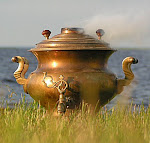Tuesday, May 3, 2011
Platonov Scholars Bring "Style, Context, Meaning" to the Samovar
I was going to title this entry “The Sluices of Epiphany”—wouldn’t it be clever, after all, to nod at one and the same time to the short story by Andrei Platonov and to the way ambrosia flows through the Samovar? In the context of “Andrei Platonov: Style, Context, Meaning” (the first North American academic conference devoted to that author), the participants of which stylishly chose to close the proceedings (where else?) in the heart of New York’s Russian-American literary life? But then I thought I had better read the story first, to see what kind of parallel I would actually be implying. Dear reader, if you do not know Russian your best hope is that nobody ever takes it into his or her head to translate this dark and linguistically very challenging work into English (although here I must immediately contradict myself by saying that Robert Chandler and his collaborators have done an amazing job with Platonov, and if Chandler happens to take on this story as well, so might you). It’s something like Silent Spring meets the GuLAG Archipelago, but compressed into a fraction of the length, and told in a mix of early 18-century-like idioms that will make your head spin. But “The Sluices of Epiphany” was published in 1927, when Rachel Carson and Alexander Solzhenitsyn were running around in short pants. Well, okay, Carson was old enough to vote. Honestly, I can hardly believe it was published, so clearly (albeit allegorically) does it condemn the Great Soviet Engineering Project and the human slavery said project entailed. And you can guess what kind of life was in store at this point for Platonov and his family.
Meanwhile, back at the Samovar… Because of what Platonov does with language in service of humanism—and you can read about that in Joseph Brodsky’s essay, “Catastrophes in the Air”—his work attracts some of the nicest, smartest and, yes, well, most idiosyncratic Slavists in the world, many of whom came together at the Samovar to relax after the conference. The Samovar was an especially meaningful venue, as Brodsky, a co-founder (see this previous entry), was an avid admirer and promoter of Platonov’s work. In the photo below of brilliant Slavist Jonathan Brooks Platt, sitting in “Brodsky’s corner,” you can see (if you look closely) that even Brodsky joined merrily in the general celebration of Platonov’s North American academic conference debut, going so far as to don a lampshade.
Subscribe to:
Posts (Atom)



